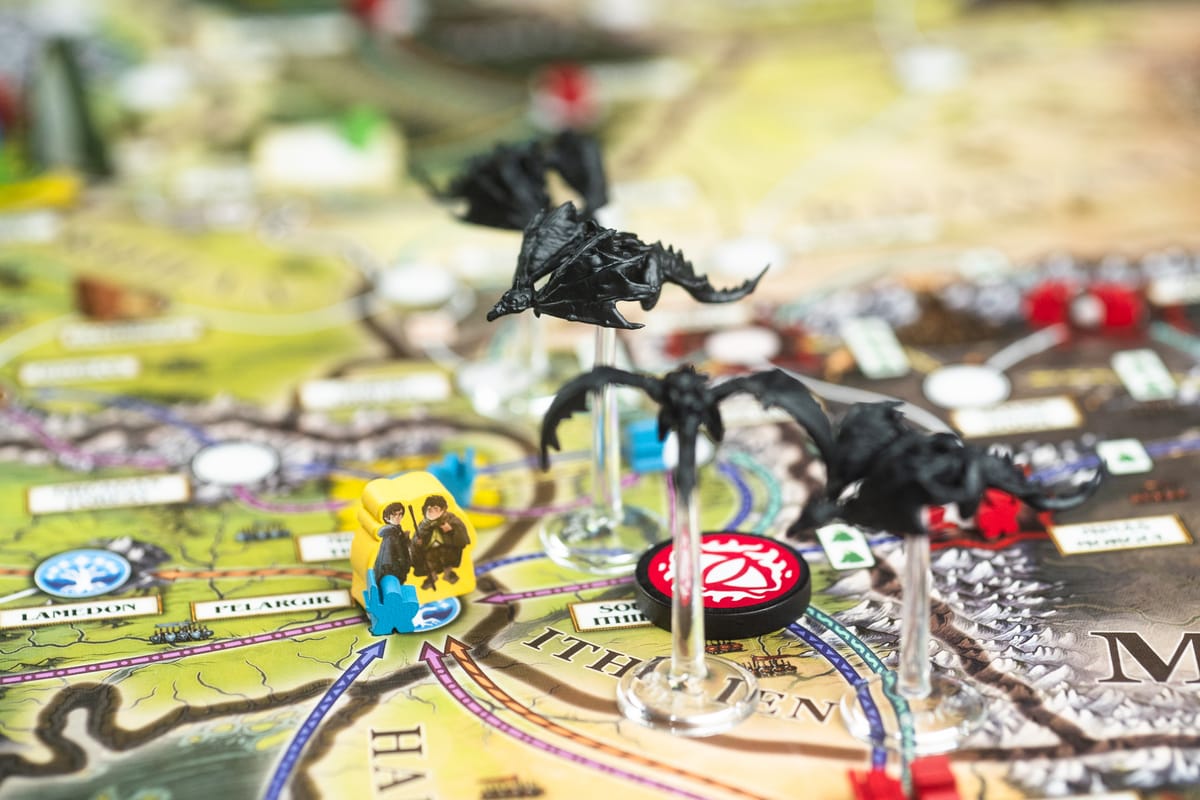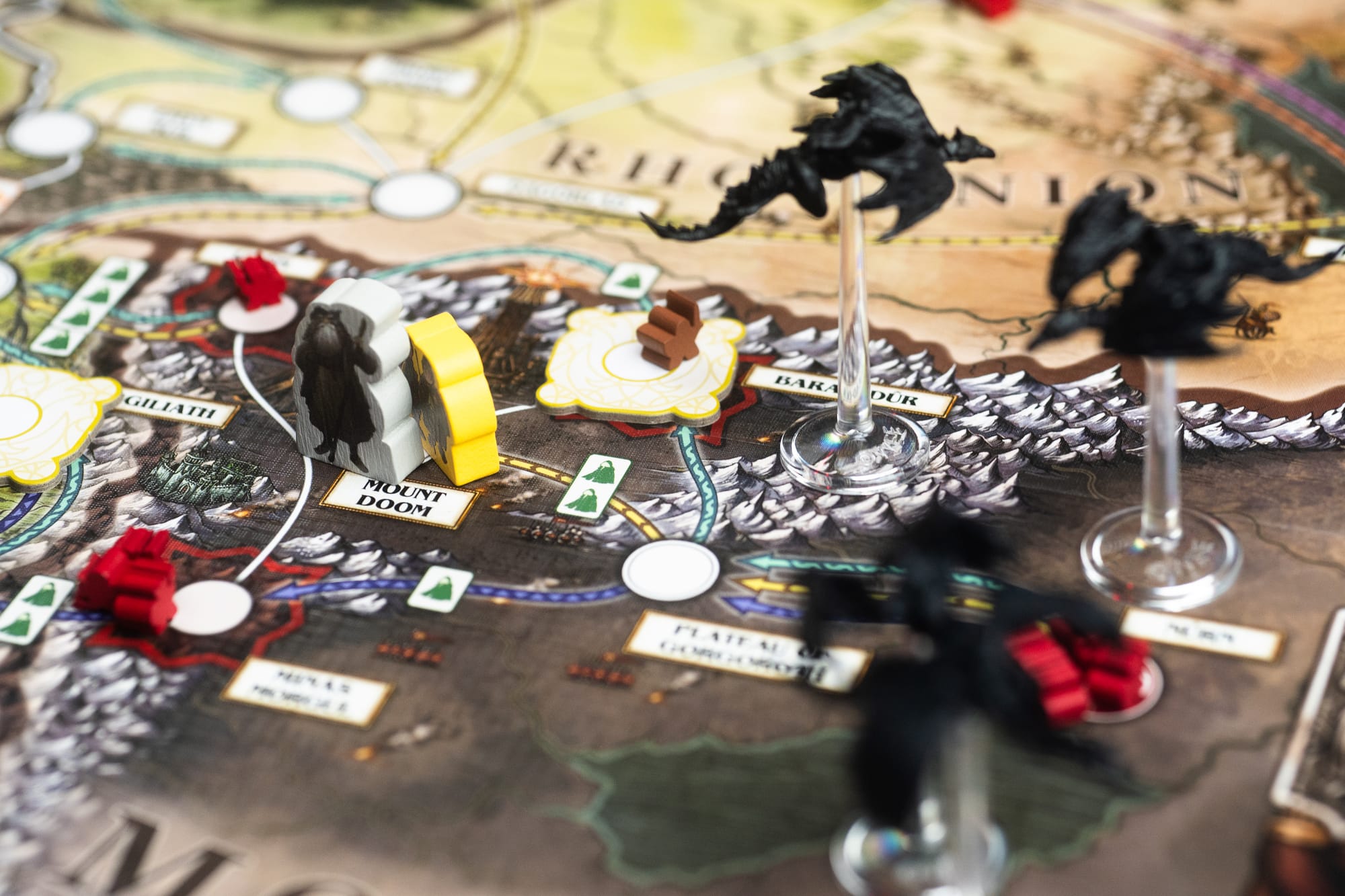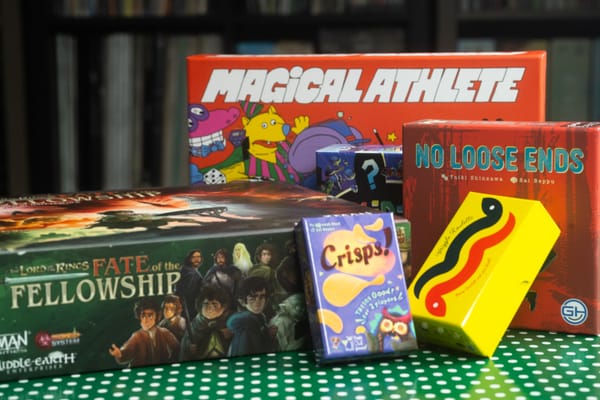Fate of the Fellowship is an impressive Pandemic spin-off
Matt Leacock's latest Pandemic offering tells the story The Lord of the Rings, piece by piece.

Few games have influenced my trajectory in playing board games as significantly as Pandemic (Leacock, 2008). For the last 13 years or so, I’ve been playing the classic cooperative game in one form or another. Whether it was Iberia (Castro and Leacock, 2016), Pandemic Legacy: Season 1 (Daviau and Leacock, 2015) or Pandemic: Rising Tide (Doumen and Leacock, 2017), there’s been a Pandemic game not far from the table at any given time.
That has perhaps faded a little over the past few years. The following seasons of Pandemic Legacy released in 2017 and 2020, and they were great, but expendable, and I haven’t gone back to them since my first campaign. The Pandemic: Hot Zone (Leacock, 2020) series just feels a bit like Pandemic in a smaller form factor and with a shorter timeframe. World of Warcraft: Wrath of the Lich King (Kemppainen, Michlitsch, Ortloff-Tang and Sanfilippo, 2021) wasn’t designed by Matt Leacock, and the theme held little interest for me, and the same can be said for Star Wars: The Clone Wars (Orloff-Tang, 2022). (I remain, it seems, a Star Trek purist. Childhood allegiances die hard.) And thus it was that some of the other Pandemic games have just sort of faded to the background, getting the occasional play but not much significant attention.
2025 has been significantly different. It’s once again a thematic tie-in property (for better or worse — I have thoughts about how popular games are being reduced to secondary media, though I don’t think they’re super relevant to this game.), but this time, it’s The Lord of the Rings: Fate of the Fellowship (Leacock, 2025). There is a rich history of great games themed around The Lord of the Rings, and this is no exception. Maybe it’s personal bias, but it feels different, a game themed around J.R.R. Tolkien’s works. Whether it’s the two-player war game War of the Ring (Di Meglio, Maggi and Nepitello, 2004), The Fellowship of the Ring: Trick-Taking Game (Bornmueller, 2024), or cooperative The Lord of the Rings (Knizia, 2000), the world of original games here is something to behold. That pedigree renders Fate of the Fellowship, alongside the return of Leacock to the Pandemic series, less a thematic tie-in and more a game that can hold its own weight. Is it fair that Middle Earth gives more weight to a game than Star Wars or World of Warcraft? Perhaps not. (To be fair, Star Trek also demands a similar level of scrutiny: There are so many Trek-themed games that are just sort of stinkers. It’s a shame, really. Of course, there are some good and great ones, too.)

But none of that means much if the game doesn’t succeed in telling the story through its gameplay. When you adapt a world so rich, you really ought to tell the story in some way. Past games have: War of the Ring tells the story of the battle between good and evil; The Fellowship of the Ring: Trick-Taking Game tells the story of the first book in the trilogy chapter-by-chapter as a campaign game. The 2000 cooperative game tells the story somewhat directly, taking you through events depicted in the story.
Fate of the Fellowship takes a slightly different approach. Each time you play the game, you’ll take on some of the important actions from the trilogy. These come in the form of objectives, of which you’ll be selecting four for the game at the standard difficulty. This is also the first major departure from Pandemic, where the objective each game remains static. It bears some resemblance to Pandemic Legacy, though those are presented chronologically as you progress through the game. In Fate of the Fellowship, you’ll be selecting objectives at the start of the game — or perhaps doling them out randomly, if you’d like. The only constant is that you must destroy the One Ring, which I suppose is fairly fundamental to the story being told. The other objectives might include freeing Theoden’s mind from the grip of Grima Wormtongue, casting out Saruman, gaining the blessing of the elves in Rivendell, and much more. (This is for you to discover, not for me to enumerate.)
By dividing the story into 24 objectives, you’re getting a slice of the story every time you play. This is an interesting twist on what other games try to do. It isn’t concerned with telling all of the story in one play, and it almost assumes that players will be taking part multiple times. The setup for the game differs in minor ways with each objective, and largely it’s either placing shadow army troops in specific locations, representing a challenge that the party will face to accomplish the objective, or it’s about using a specific character in the game. The objectives themselves usually surround a condition that must be achieved throughout the game, often around converting locations to havens.

Havens have no clear analog in classic Pandemic, and they are not closely related to havens in the Pandemic Legacy series. In essence, a haven represents a stronghold for the Free Peoples (which is to say, Elves, Dwarves, and two types of troops of Men, the Rohirrim and armies of Gondor, though I know them better as green, grey, brown and blue, respectively) in the battle against Sauron and his armies. When you place those enemy armies (of which there is only one type and supply), they cannot be placed in havens. They can, however, be reconquered, causing the party to lose Hope. Ah — another piece of the puzzle, and another way this game differs in key ways from Pandemic.
Running out of Hope is one of the ways you can lose the game, and it’s just a little track you’ll be moving around. There are no outbreaks to contend with, so this sort of replaces it. You’ll gain hope by converting shadow strongholds to havens, and you’ll lose hope when they’re conquered. You also have plenty of opportunities to lose hope with Frodo, but we’ll get there in just a moment. As the game progresses, shadow armies will move on the board through specific paths. This strongly resembles the way armies in Fall of Rome (Leacock, 2018) move and progress toward the titular city. When they encounter armies of the Free Peoples, a battle ensues. If the shadow armies move into a haven and there are no armies defending it, it’s immediately converted to a shadow stronghold, hope is lost, and shadow armies can again be placed there when drawn.
These changes are anchored by characters, each of which has a set of unique abilities. The only ever-present is the combined Frodo and Sam character, who, as you’d imagine, needs to be the character performing the final action of the game by casting the One Ring into Mount Doom. (This is accomplished by discarding five Ring symbols, either through cards or tokens. Ah, tokens! I’ve barely scratched the surface here.) The four Hobbit characters are divided into two groups, which fits from a story perspective. (Gollum is here, too, but he’s on his own — and kind of weird. Fitting.)
Unusually, you’ll actually be playing with two characters rather than just one, and that’s the game’s final big twist. On each turn you take, you’ll be taking four actions with one character, and you’ll be taking one action with another. While at face value it may not seem that fundamental to play, I’ve found it’s actually the game presenting both a benefit and a constraint simultaneously. When you plan your turn, you’ll have to think about where you want to take the majority of your actions. Will you continue with Gimli hacking through armies in Rohan? Will Legolas escort Frodo and Sam to Mount Doom? Will Boromir be tasked with holding down Isengard? There are options aplenty on your turn, and that’s where the game really splits from Pandemic in my thinking.
Often in Pandemic, there are obvious actions to take, especially in the early game. They’ll vary based on the game state and the game’s setup, but the more you play, the more you know that you just have to take care of cities before there’s an outbreak, that you’ll want to establish zones of control, and that you’ll what to build a research station or two early on. Not every game will flow exactly the same, but the themes are there every time. Perhaps it’s because Fate of the Fellowship is new to the scene, but having played the game more than two dozen times on Board Game Arena, those same patterns just aren’t emerging in the same way. There are some patterns, and there are certainly patterns I’m missing, but I’m finding myself caught between two considerations: Will I aim to protect havens from shadow armies, preventing a loss by zeroing out my hope, or will I rush through objectives as quickly as possible, taking care of troops only when convenient? This is, of course, a false dilemma. You can try to do both, even if you’re doing it somewhat poorly.

That fundamental conflict plays out every turn as you balance which character will take four actions with the character that will take one action. Early on, it allows you to navigate tricky waters, especially for the player controlling Frodo and Sam. See, Frodo and Sam are different than the other characters, in that there are Nazgûl and the eye of Sauron searching for the bearer of the ring. Every time Frodo moves, a search is performed, with a die rolled for each Nazgûl and shadow army. Those dice feature two ways hope is lost, which largely means that Frodo’s moving around either in safe regions or through the use of stealth. (You can also put on the ring, but that’ll result in lost hope, too.)
None of this is a sufficient rules explanation, which is a great illustration of why rulebooks should not be written as a stream of consciousness exercise. (The rulebook for this game is actually quite good, too! Read it! I know there are good videos out there, but at least skim it, OK? Know where things are so you can look them up later. Alright.)
Unlike the other games in the Pandemic series, this one sets out to tell a specific story in any way the players choose. Unlike the Legacy games, that story isn’t linear (or nearly linear, as the case may be.) Where the Legacy games felt like they cribbed mechanics from the other games in the series, this one feels like it’s almost an extension of the Legacy games, but there’s no permanence here, there’s nothing to reset. When you’re done, the game goes back in the box. There’s no teardown, no setup for the next time you play.
I’ve waxed a bit poetic here, but it’s not even that Fate of the Fellowship is a perfect game or perfect for every group. (I could complain here about how small the units are in the game. It was a real ordeal getting them set up properly, each standing upright instead of on their heads. It’s a small gripe, but I think it’s a valid one. Maybe the game should have come with tweezers.) I’m confident this is a game that speaks to fans of The Lord of the Rings, both passionate and passing. I’m confident that this is a game that speaks to fans of Pandemic, and I do think it takes the series in some exciting directions.
That’s probably the thing I’ve thought about the most with this game, that it takes Pandemic in new directions. I’ve wondered often what Matt Leacock would do next in the series. After two thematic reimplementations of Pandemic with Star Wars and World of Warcraft, neither of which involved him, I wondered if the series was only going to be deployed for the ease of which the mechanics could be fit into another universe. (Pandemic: Universes Beyond, right?) That’s not dispelled here; The Lord of the Rings remains a profitable IP, if we’re thinking cynically about the world. (I do think there’s something about the trilogy and Tolkien’s works more generally that makes for great games, though. We talked about that earlier.) What is dispelled, though, is a certain cynicism creeping into the series.
This is not a cheap retheme, which is not to say the two I mentioned earlier were — I’ve not played them. Those two don’t look like they’ve just been shipped out as quickly as possible, but as we’ve seen with the thousands of rethemes of Love Letter (Kanai, 2012), Asmodee is not above that. (They’re also not above doing that with The Lord of the Rings in that context — see also: Love Letter: The Hobbit — The Battle of the Five Armies (2015). Every piece of this game feels intentional, crafted and honed. It’s a game that has Matt Leacock’s cooperative fingerprints all over it.
Thanks for joining me this week for another edition of Don’t Eat the Meeples! I know this was all a bit scattered, but I was excited to get some thoughts about the game on (virtual) paper. I’m looking forward to some gaming over the next few days — I just got a copy of Numberwang (Babakitis, 2025), a trick-taking game with a slightly unusual bidding scheme in that you look at everyone’s cards at the beginning of the round before making bids. I also have a copy of Hot Dog (Babakitis, 2025), and that’s a partnership trick-taker about mismatched quantities of buns and hot dogs. Fun! I’ve also got the Xylotar and Rebel Princess expansions (and the base games) that I’ll be looking to play over the next week, as I’m out of town for a wedding. It should be a lovely time, though anything with a two-year-old holds the potential to be a bit chaotic, typically in the best of ways.
OK — I suppose that’s about all. Though I would love to keep chatting, I really should get some rest.





